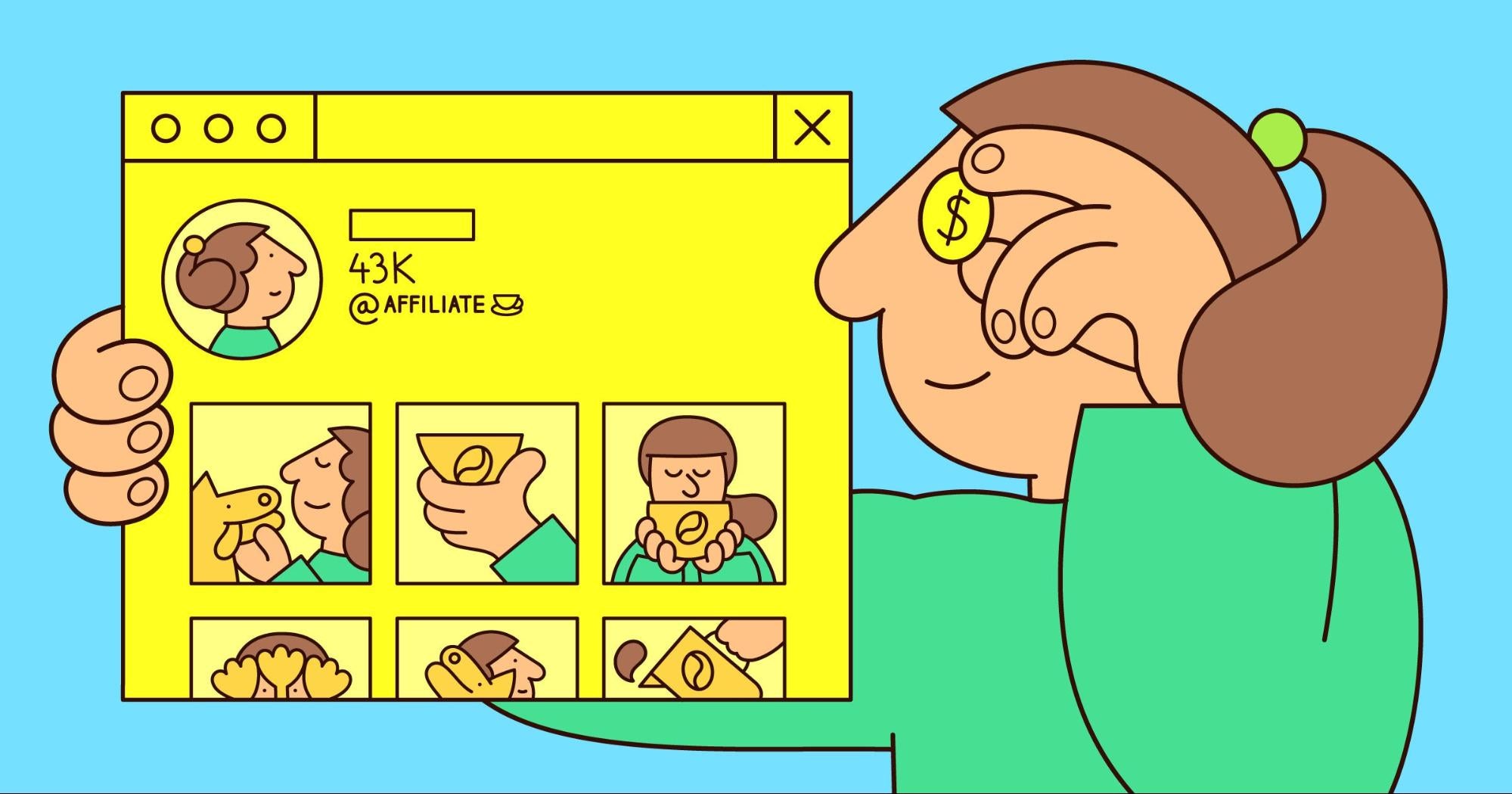With affiliate marketing, brands and content creators benefit from working together. Brands get access to the motivated audiences of bloggers, podcasters, and social media influencers. In return, creators make a commission on sales or referrals, providing a stable way to monetize their content.
This guide explains how to become an affiliate marketer and make money by promoting products. Below, find tips from affiliate marketing experts and examples of popular affiliate programs.
Looking to start an affiliate program? Here’s how to recruit and manage affiliates for your business.
What is affiliate marketing?
Affiliate marketing is a performance-based marketing strategy where creators, influencers, and entrepreneurs earn money by promoting a product or service for a retailer.
Affiliates encourage their audiences to visit an online store or marketplace through affiliate links that track where a user came from. While most affiliates get paid when their referrals lead to a sale, some programs also reward leads, free-trial signups, website clicks, or app downloads.
An affiliate network is a platform that connects affiliates with brands and provides tools to generate and manage affiliate links.
In recent years, affiliate marketing has gained a reputation as a lucrative online business strategy that supports creators, entrepreneurs, and those looking for a side hustle.
How affiliate marketing works
Many affiliate programs are free to join. Affiliate programs work by allowing individuals or businesses to promote and sell the products or services of another company in exchange for a commission on each sale.
The affiliate earns a commission each time someone makes a purchase through the unique affiliate link associated with their recommendation.
Here’s how affiliate marketing works at a high level:
- An affiliate promotes an affiliate link to their website visitors, blog readers, or social network.
- An audience member clicks the link.
- The audience member makes a purchase.
- The affiliate network records the transaction.
- The affiliate gets paid a monetary commission.
Commission rates for affiliate sales vary depending on the product, industry, and the agreement negotiated between the affiliate and brand.
Low-price, high-volume products in niches such as pet food or skin care might earn you 5% of each sale. High-ticket affiliate programs in sectors such as finance and software can offer more than 20%.
Successful affiliates may negotiate bespoke deals with their partners for even higher percentages. Some affiliate marketing programs provide a flat rate per sale instead of a percentage.
Become a Shopify Affiliate
Join the program to grow your brand, access exclusive opportunities, and earn a competitive commission for each new business you refer to Shopify.
Apply now
3 types of affiliate marketing
1. Unattached affiliate marketing
Unattached affiliate marketing is when the affiliate is a general advertiser or promoter. They are not associated with the affiliated brand, product, industry, or niche, and may promote a wide range of affiliate products to multiple audiences.
Unattached affiliate marketers often use pay-per-click (PPC) advertising campaigns to reach customers on social media and search engine results pages.
2. Related affiliate marketing
Related affiliate marketing is the practice of promoting products or services that are relevant to an affiliate’s audience. An affiliate in this category has invested resources to build a following through blogging, YouTube, TikTok, or other types of content marketing.
Related affiliate marketers may be influencers, making them a trusted source for recommending products.
3. Involved affiliate marketing
Involved affiliate marketing refers to the creation of content that includes an affiliated product or service. This could be a product review, a walkthrough, or other content that demonstrates product benefits.
Many involved affiliate marketers gain a reputation for trustworthy, impartial product recommendations. Earning an audience’s trust is a sustainable way to build an affiliate marketing business.
GearLab has built a reputation for in-depth outdoor gear reviews and monetized its content with affiliate links. GearLab
Pros and cons of affiliate marketing
Affiliate marketing spending surpassed $8 billion in 2022 and continues to grow. For creators, it’s a low-cost way to start a business that almost anyone can try.
Before diving in, consider these pros and cons of affiliate marketing.
Affiliate marketing pros
Easy to execute
In affiliate marketing, the main goal is straightforward: refer customers to your partner retailer. Affiliates can focus their efforts on marketing and leave other difficult tasks, such as product development and order fulfillment, to the retailer.
Low investment and risk
Joining an affiliate program typically doesn’t cost anything. Once an audience is established, affiliates can start earning money by promoting a product without additional investment. This can lead to (relatively) passive income from commissions.
Ability to scale
When successful, affiliate marketing can increase earnings without the need for additional employees or resources. Affiliates can introduce new products to their audience, negotiate higher commissions, or reinvest earnings to expand their reach.
Affiliate marketing cons
Takes time
Contrary to some beliefs, affiliate marketing is not a get-rich-quick scheme. Growing an audience and gaining influence requires time and dedication. It may take several years of consistently creating and publishing content before you earn a regular income.
Limited control
Affiliates have to follow the rules set by an affiliate program. This may include limitations on how a product can be promoted.
Another limitation of affiliate marketing is the commission-based revenue model, which means that affiliates will earn only a fraction of each sale.
If you are successful at referring customers to a particular company, you may be able to negotiate with them for better commissions, bonuses, and access to more impactful marketing content (such as promotions) for your audience.

Listeners of The Joe Rogan Experience podcast are offered a special discount for an affiliated software product. Express VPN
Who should become an affiliate marketer?
For new businesses, affiliate marketing is a way to earn money with low overhead costs. For established creators, it’s a chance to generate additional income from an existing audience or content portfolio.
Here are three signs that affiliate marketing could be a good fit:
You have access to an audience
If you’ve built an engaged following, you could be in a prime position to leverage affiliate marketing. This could be a large general audience or a smaller community of dedicated hobbyists and enthusiasts.
For example, a wellness podcast could partner with products that align with its audience’s interests, like a vitamin supplement, meditation app, or a luxury mattress.
You’re a content wizard
If you have a knack for pleasing platform algorithms and reaching a large number of users, affiliate marketing could be a relevant business model.
Many affiliate marketers generate referrals by optimizing a website to rank highly in search engine results. Others are pros at creating viral content for Instagram Reels or YouTube.
You’re a trusted guru
If you’re an expert on a range of niche products, you can use your knowledge to succeed in affiliate marketing. Creating educational content is a powerful way to persuade customers to click through to partner websites.
How affiliate marketers make money (and how much)
As you join affiliate programs, you’ll notice different payment models. Programs may also refer to payment models as pricing structures, payout models, or conversion types.
A payment model tells affiliates what user behavior they will be paid for. For example, if you’re promoting a software product, the goal could be a free trial signup. For affiliate marketers promoting physical products, the goal will likely be a purchase.
Many affiliate marketing programs run on last-click marketing attribution, which means the affiliate who receives the last click before purchase gets 100% credit for the sale.
5 ways affiliates get paid
- Per sale. Affiliates earn a commission for each sale made, a common payout model for ecommerce offers.
- Per action. A commission is earned for a specific action such as a newsletter signup, contact request, or form submission.
- Per install. Affiliates are paid for every app or software install generated.
- Per lead. Affiliates are paid every time a lead is generated.
- Per click. Commission is earned for every click on an affiliate link. This model may be used by large merchants with the goal of building brand awareness.
How much can affiliate marketers make?
Data from 2023 suggests most affiliates earn at least $1,000 per month from affiliate links promoted on social media. When combined with a website or other marketing channels, it’s clear that affiliate marketing can be a profitable full-time business.
According to compensation software company Payscale, the average annual salary of an affiliate marketer is more than $56,000, based on more than 7,000 salary profiles. However, many affiliate marketers earn significantly more.
Generally, the larger the following, the more money that can be made online as an affiliate marketer. But don’t underestimate the power of a small audience of high-value customers: this can be equally profitable.
How much an affiliate makes depends largely on the niche. For example, business-related affiliate programs offer significantly higher commissions than books, media, or clothing programs.
At the same time, it’s important to consider a niche’s conversion rate—the likelihood of a successful referral. Weigh the value of a referral against the effort it’s likely to take.
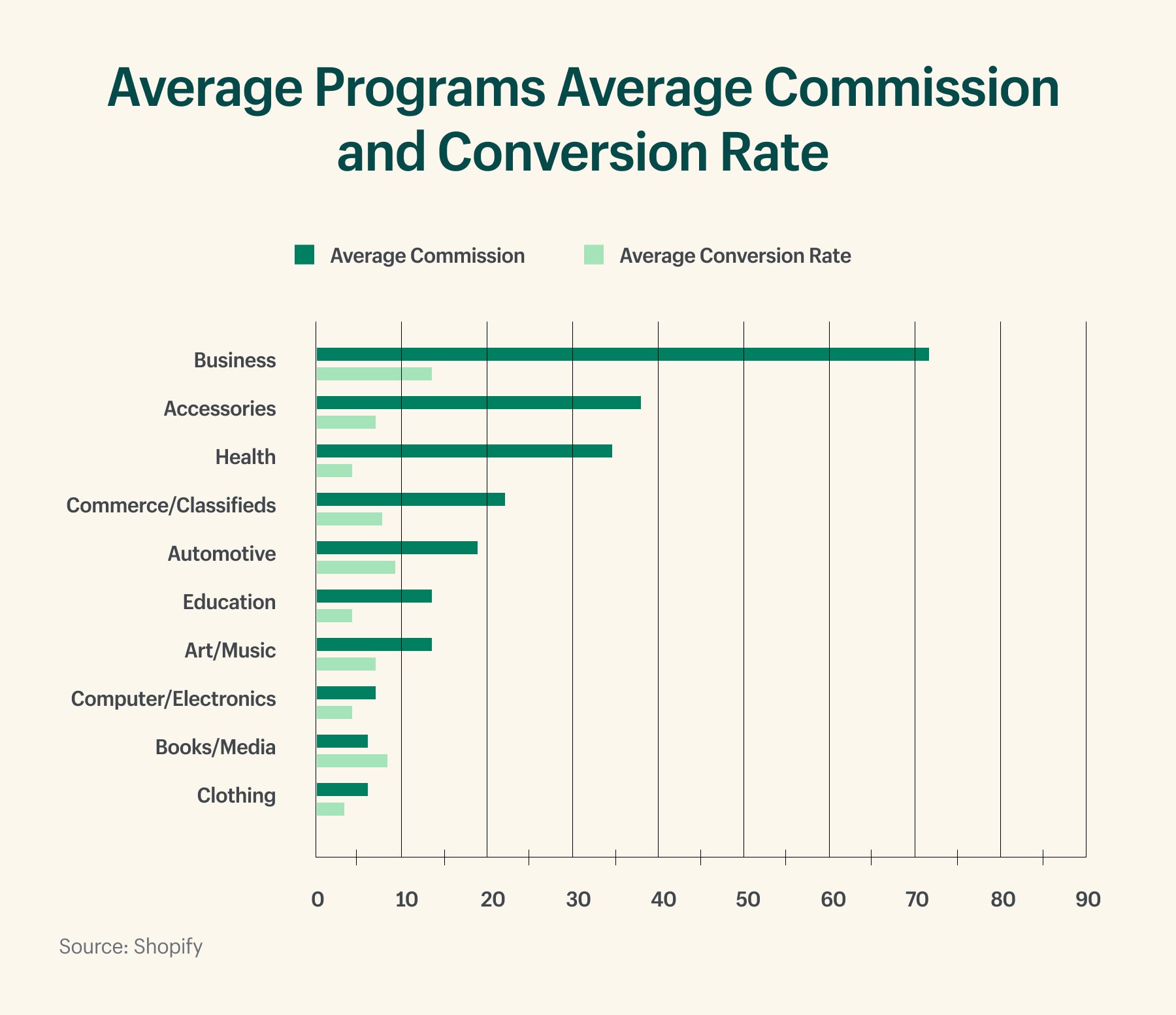
Data gathered from 200 affiliate programs selected at random from an affiliate network site over a seven-day period (December 7–14, 2021).
How to start affiliate marketing in 4 steps
- Pick a channel and format
- Determine your niche
- Find an affiliate program
- Choose your first product
1. Pick a channel and format
The first step to becoming an affiliate is selecting a marketing channel for reaching your audience—and a type of content to create for that channel.
Common marketing channels include:
Popular content formats include:
- Product reviews
- “Best of” product lists
- Curated product recommendations
- Product comparisons
- Lifestyle content
When choosing a channel and format, consider the platforms you use most and the formats you understand best. Starting with a familiar marketing channel can help produce high-quality content, leading to a more engaged audience.
No matter which route you take, authenticity is key in affiliate marketing. Without a genuine connection with the audience, converting them into affiliate sales may prove challenging.
2. Determine your niche
When selecting a niche, affiliate marketers usually follow one of two paths:
- They choose a niche they’re passionate about
- They select a niche based on audience analysis
Choosing a niche you’re already knowledgeable about can help you appear authentic and trustworthy to potential customers. It also aids in evaluating which products and brands to promote.
Say you started a blog when you adopted a dog, to document your journey as a new pet owner. In this situation, it would make sense to select an affiliate niche within pet care. This allows you to promote products relevant to your content and audience.
On the other hand, selecting an affiliate marketing niche based on audience analysis can uncover potentially profitable areas that are less competitive. This approach might help you establish a presence in untapped areas before other affiliates spot the opportunity.
However, this method means you’ll be competing with content created by people who likely know more about the topic than you do. To succeed, you’ll need to use affiliate marketing tools like social listening, website analytics, and social media insights to understand your audience’s preferences.
3. Find an affiliate program
To earn revenue as an affiliate marketer, the items you promote need to be relevant to your audience. Getting this wrong can hinder your success and diminish your credibility.
If you’re unsure where to find products or brands to partner with, there are many popular affiliate networks to browse, including:
Another option is to visit the websites of businesses to see if they work with affiliates. Many businesses offer affiliate programs, such as the Shopify Affiliate Program.
A more direct approach is to reach out to the owner of a product you find appealing and inquire if they have an affiliate marketing program. If they don’t, they might be open to setting up an arrangement, such as providing a special coupon code for you to share with your followers.
Remember, affiliate marketing programs have terms of service that need to be adhered to, so always read the fine print. For instance, your affiliate link will usually have a cookie with a specified timeframe, and some programs don’t allow pay-per-click ads using the product or company’s name.
Get paid by brands you love with Shopify Collabs
Shopify Collabs makes it easy to find brands that match your vibe, build affiliate relationships, and get paid for what you sell.
Find brands
4. Choose your first product
As you brainstorm products or browse through affiliate platforms, the most important criteria to keep in mind is that the products you promote should be aligned with your audience, or the audience you hope to build.
Ask yourself:
- Is this product something my target audience would find valuable?
- Does it fit with my area of expertise? My brand?
Also, ensure the product or service you’re promoting is suitable for the platform you’re using. For instance, home décor and clothing might perform well on image-heavy platforms like Instagram. However, for more complex purchases, like software, your conversion rates might be higher on platforms that allow for more in-depth content, like a blog or YouTube.
How to join Shopify’s affiliate program
The Shopify Affiliate Program is open to educators, influencers, and content creators from across the globe. Shopify affiliates inspire people to begin their entrepreneurship journey with Shopify—or show existing merchants the benefits of moving their business.
It’s free to become a Shopify affiliate. Once accepted to the program, you’ll earn a commission each time a Shopify merchant completes a free trial and commits to a full-price plan.
Here’s what you need to know about becoming a Shopify affiliate.
Affiliate criteria
To be considered for Shopify’s affiliate program, you must:
- Own and run a website
- Have an established audience
- Create original content, such as online courses, articles, or videos
- Have experience with Shopify or other ecommerce platforms
As an affiliate, you’ll also need to comply with Shopify’s brand guidelines to make sure you’re correctly using branded assets.
Application process
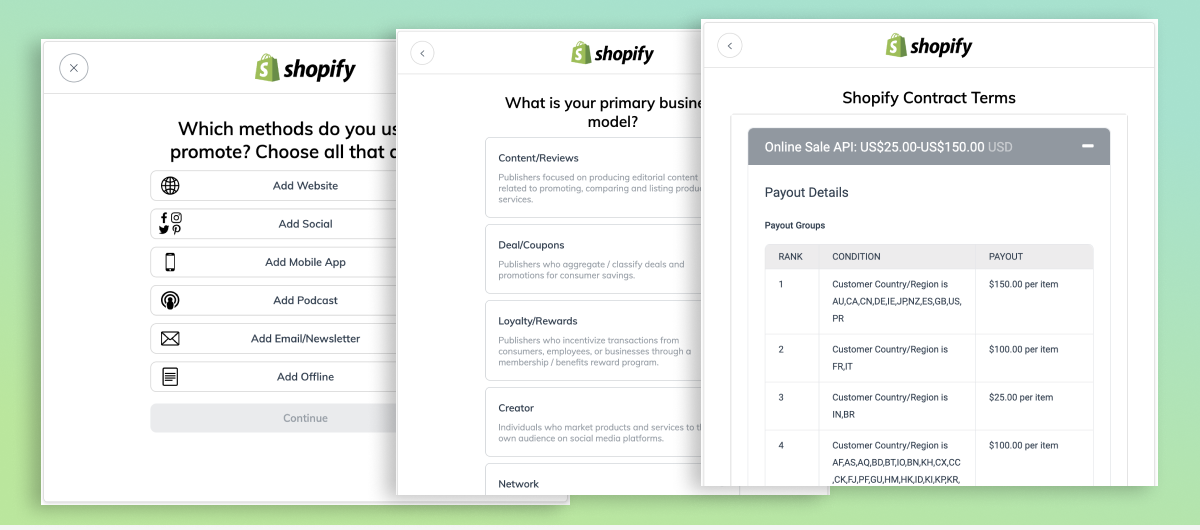
To become a Shopify affiliate, fill out this application form. It takes around five minutes to complete.
As part of the application process, you’ll need to accept Shopify’s contract terms, which include payout amounts for referrals by location. The terms also explain how you’ll be paid.
Tell Shopify how you plan to refer merchants—for example, by creating review content, offering courses, or talking to your existing audience.
After that, you can connect your promotional channels to your application. Add your website, social accounts, podcast, newsletter, or other methods of reaching potential customers.
Unless you already use Impact (Shopify’s affiliate management platform), you’ll also need to sign up for an account. You can do this within the application form.
Impact
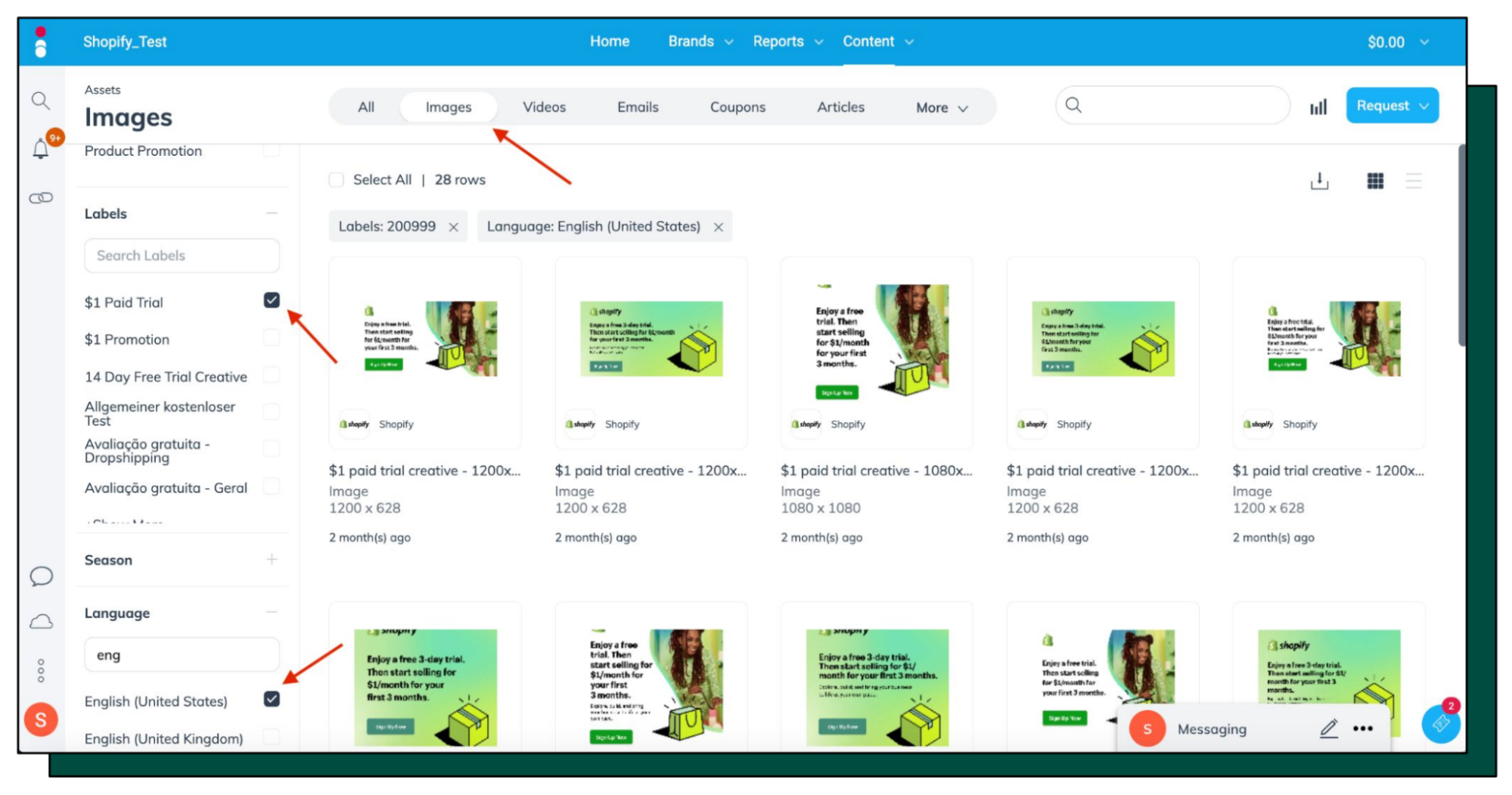
Introduction to Impact
Shopify uses Impact, a third-party software, to manage its affiliate program. Affiliates can generate and manage referral links through Impact.
Inside Impact, you’ll find thousands of pre-made referral URLs and creative assets, which the Shopify design team has uploaded. Each asset has been tested to ensure it drives conversions.
You can also attach affiliate links to your assets and add tracking codes to see which links perform well. Shopify’s tracking cookie window for affiliate links is 30 days.
Once you’ve applied
Shopify will review your application and let you know the outcome, usually within three to five days.
If your application is approved, you’ll get an email confirming acceptance, along with links to some tools to help you get started.
Check out this help documentation for more information about the Shopify Affiliate Program, including how affiliates get paid and tips for building your affiliate strategy.
9 tips for affiliate marketing success
1. Build trust
Of all the affiliate marketing tips from experts, one is universal: Be trustworthy. Don’t risk your brand image for any affiliate partner or product.
Being trustworthy means publishing honest content. If you’re reviewing a product, share your genuine opinion based on your experience. The more open you are, the more authentic you seem.
Trust becomes more vital in certain niches. For example, promoting a $1,000 online course requires more trust than selling a $20 t-shirt.
Desirae Odjick, founder of personal finance blog Half Banked, suggests building trust by sticking to a “limited number of affiliates, or by only promoting products you personally use.
“For instance, people trusted my recommendations for Canadian financial apps, but I might not have been successful as a Sephora affiliate.”
2. Talk to product users and experts
Consider interviewing people who use the product or service you’re promoting. Alternatively, create content about a product’s brand or inventor.
Contextual content can add depth to your reviews and create a narrative for readers to engage with.
3. Create a product tutorial
Another effective strategy is to create a tutorial for the product or service you’re promoting.
People frequently search for how-to guides, like “How to save money for college” or “How to decorate a laundry room.” By offering a tutorial that solves a searcher’s problem and clearly highlights a product’s value, your referrals provide a stronger incentive for the customer to purchase the product you’re recommending.
4. Build an email list
An email list is an effective way to stay connected with people after they’ve logged out of social media and closed their internet browser.
Consider writing and sending a weekly newsletter to your subscribers that promotes your affiliate partners. Aim to provide something valuable to your readers, such as:
- Free downloads
- Reports
- Insights into your life or business
- Entertaining stories
- Updates and news
- Special deals
If a subscriber responds to your email, make sure to reply. Consistency in the frequency and quality of your newsletters is key. Occasionally, you can promote an affiliate product or two.
There’s no strict rule on how often to send promotional emails. However, avoid sending them every time you have a promotion, as this may appear spammy and damage your trustworthiness.
Create branded emails in minutes with Shopify
Easily create, send, automate, and track email campaigns all from your Shopify admin—no coding required.
Discover Shopify Email
5. Find relevant search terms
If you’re promoting a product through a blog post, research the keywords that someone might type into a search engine to find your content.
The Google Ads Keyword Planner is a useful tool for this purpose. It’s free to use, but you’ll need to create an account.
6. Use the product
Creating first-hand instructional or tutorial content is a good way to encourage your audience to try a product for themselves.
For example, you could create a video where you demonstrate a physical product in common real life scenarios, or explain how to get the most out of a digital product. Your personal experience and insights can add depth to your content and make it more relatable.
Unboxing posts are a popular type of involved affiliate marketing. If you receive the product in the mail, consider documenting your experience of opening it. This can create a sense of anticipation and excitement among your audience, making them more likely to consider trying the product themselves.
7. Set your distribution strategy
Once you’ve written your promotional content, share it on your website or social media platforms. If you have a subscriber list, you can create an email marketing campaign.
8. Lead with a discount code or bonus offer
Sometimes, marketers promote affiliate programs by offering bonuses to anyone who purchases the offer. For example, you could give a free ebook to any follower who makes a purchase.
Promotions like this encourage customers to buy by sweetening the deal. They’re especially persuasive if the bonus you offer is something you normally sell, because shoppers can appreciate its dollar value.
For example, Talking Shrimp is an affiliate of the online entrepreneurial course B-School. It offers bonus access to its own copywriting content, which is likely to be of interest to B-School subscribers.
9. Keep things legal
Always disclose when content contains affiliate links. Not only is this required by the FTC, but explaining your affiliation can help build trust.
For example, financial independence blog Frugalwoods offers this disclosure:
“Frugalwoods.com contains affiliate links. Meaning frugalwoods.com receives commissions for purchases made through those links, at no cost to you. Please understand that we have experience with all of these companies and recommend them because they are helpful and useful, not because of the small commissions we make if you decide to buy something.”
If you need help figuring out what language to use in a disclaimer, it’s worth taking time to consult a legal professional.
Affiliate program examples
Take a look at these popular affiliate programs to understand the different payout models, products and services that you can promote.
Shopify
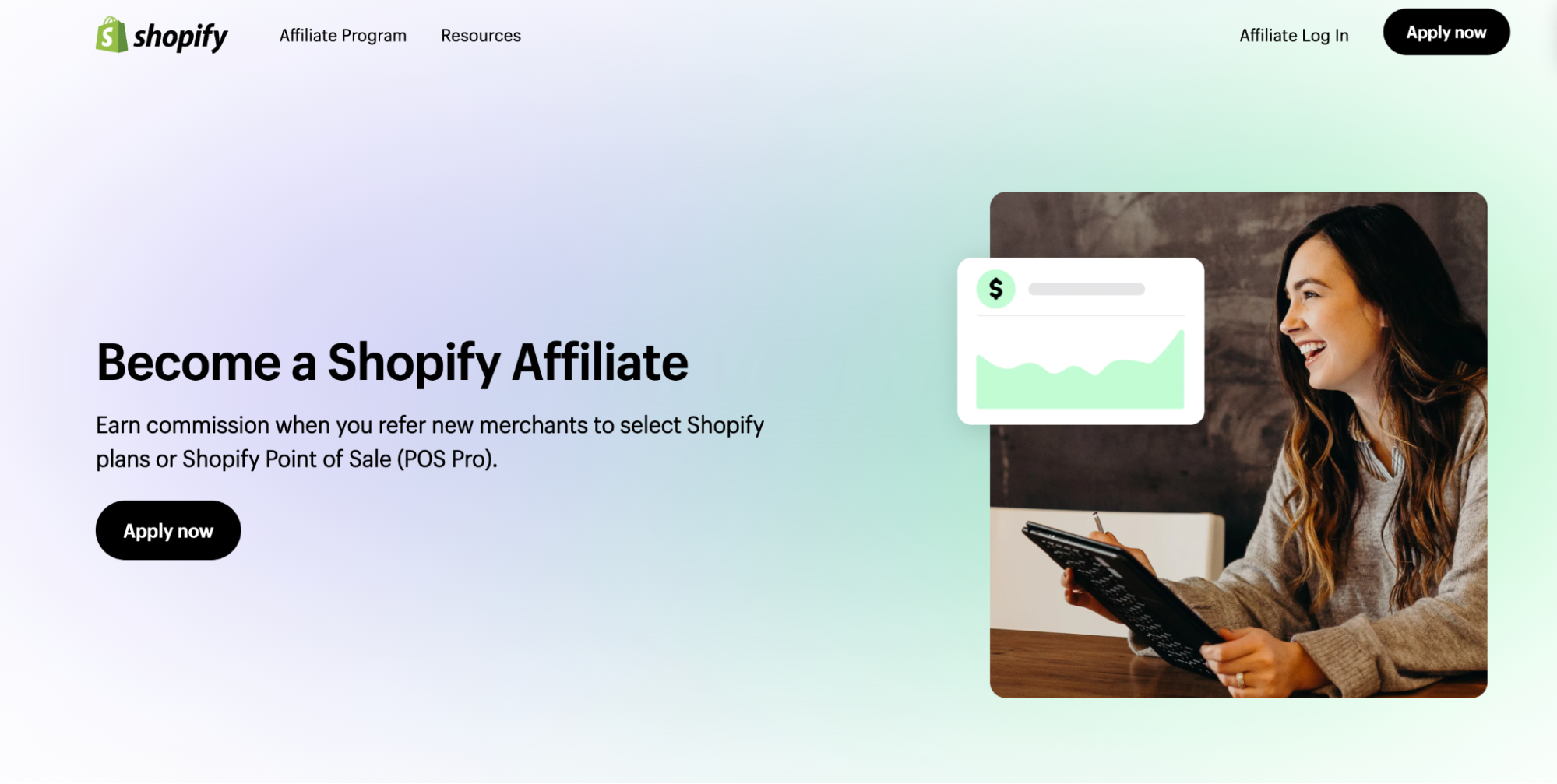
Shopify’s Affiliate Program is a community of entrepreneurs, educators, influencers, and creators who refer customers to Shopify. Joining the affiliate program is free—all you need to do is apply.
Once approved, affiliates receive a unique link to share with their audience. Each time someone signs up using this link, the affiliate earns income.
On average, Shopify Affiliates earn $58 for each user who signs up for a paid Shopify plan. The earning potential is unlimited and depends entirely on the success of your marketing strategy.
Smart Marketer’s Ezra Firestone considers the Shopify affiliate program one the most accessible he’s encountered in more than a decade of digital marketing.
“Shopify made it easy for me to promote their product, make money, and provide value to my community,” he says.
Healthish
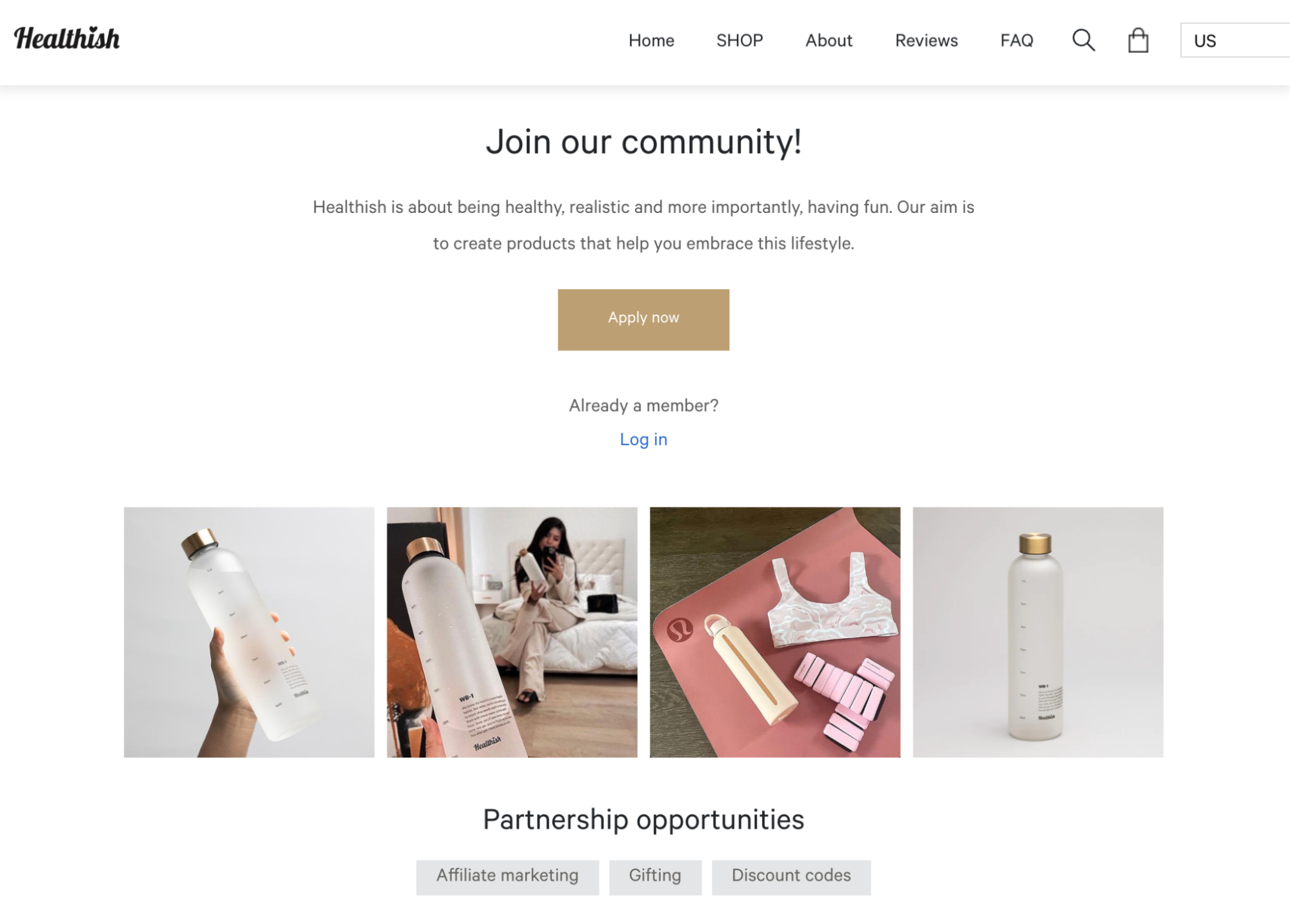
Healthish
Water bottle retailer Healthish used affiliate marketing to build a million-dollar brand. It partnered with Instagram influencers to build awareness for the launch of its keystone product, the WB-1 bottle.
The Healthish affiliate program continues to work with influencer accounts with 100,000 followers and up. It works with around 300 creators per month to create content that markets and sells at scale.
Frankies Bikinis
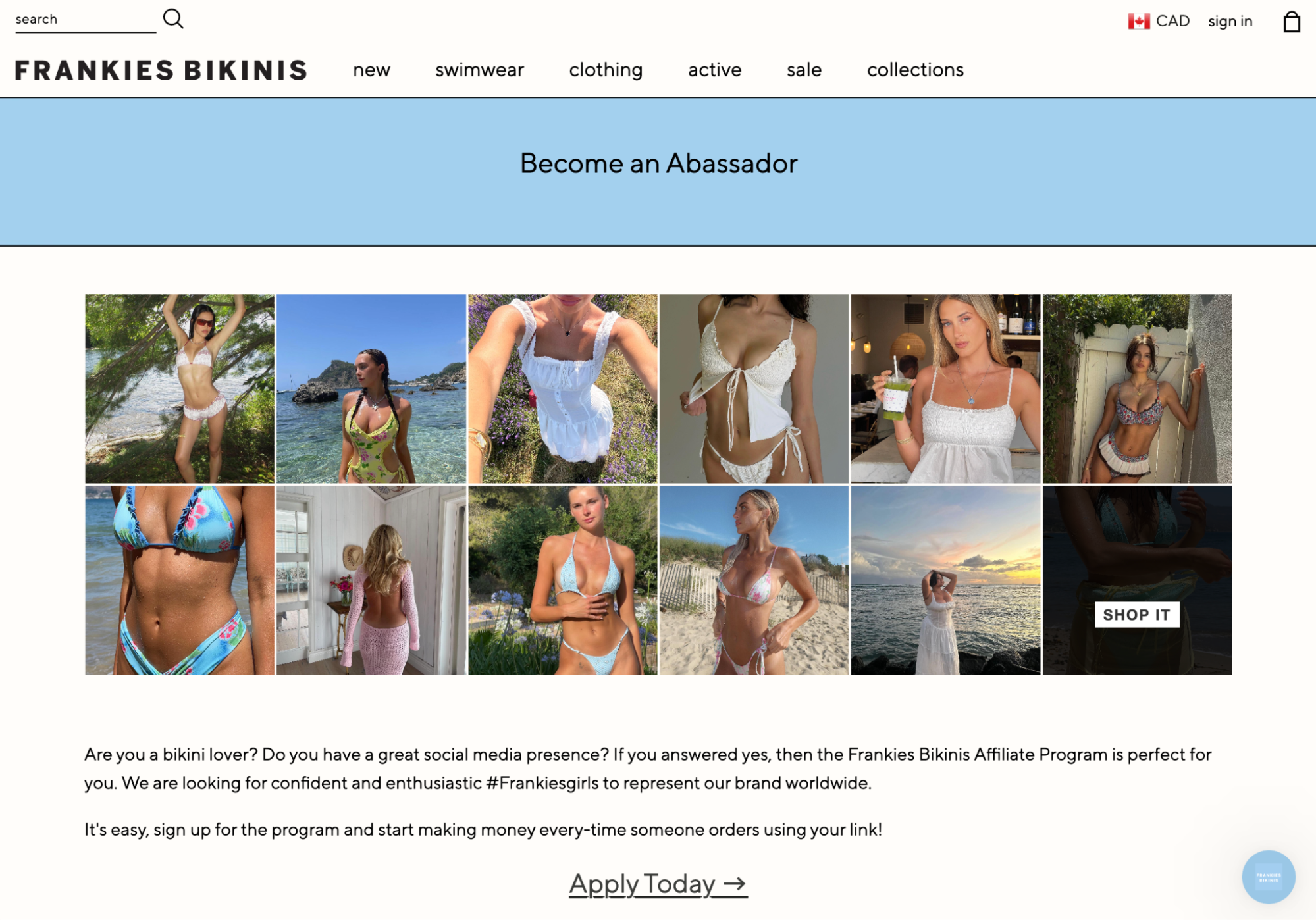
Frankies Bikinis
Swimwear brand Frankies Bikinis refers to its affiliates as ambassadors, hashtagged #Frankiesgirls. It uses ShareASale, RewardStyle, and Skimlinks to manage its affiliate program. The brand encourages brand advocates with a strong social presence to apply. Commissions are paid in cash, and the brand offers an updated list of active promotions for ambassadors to use.
Juice Beauty
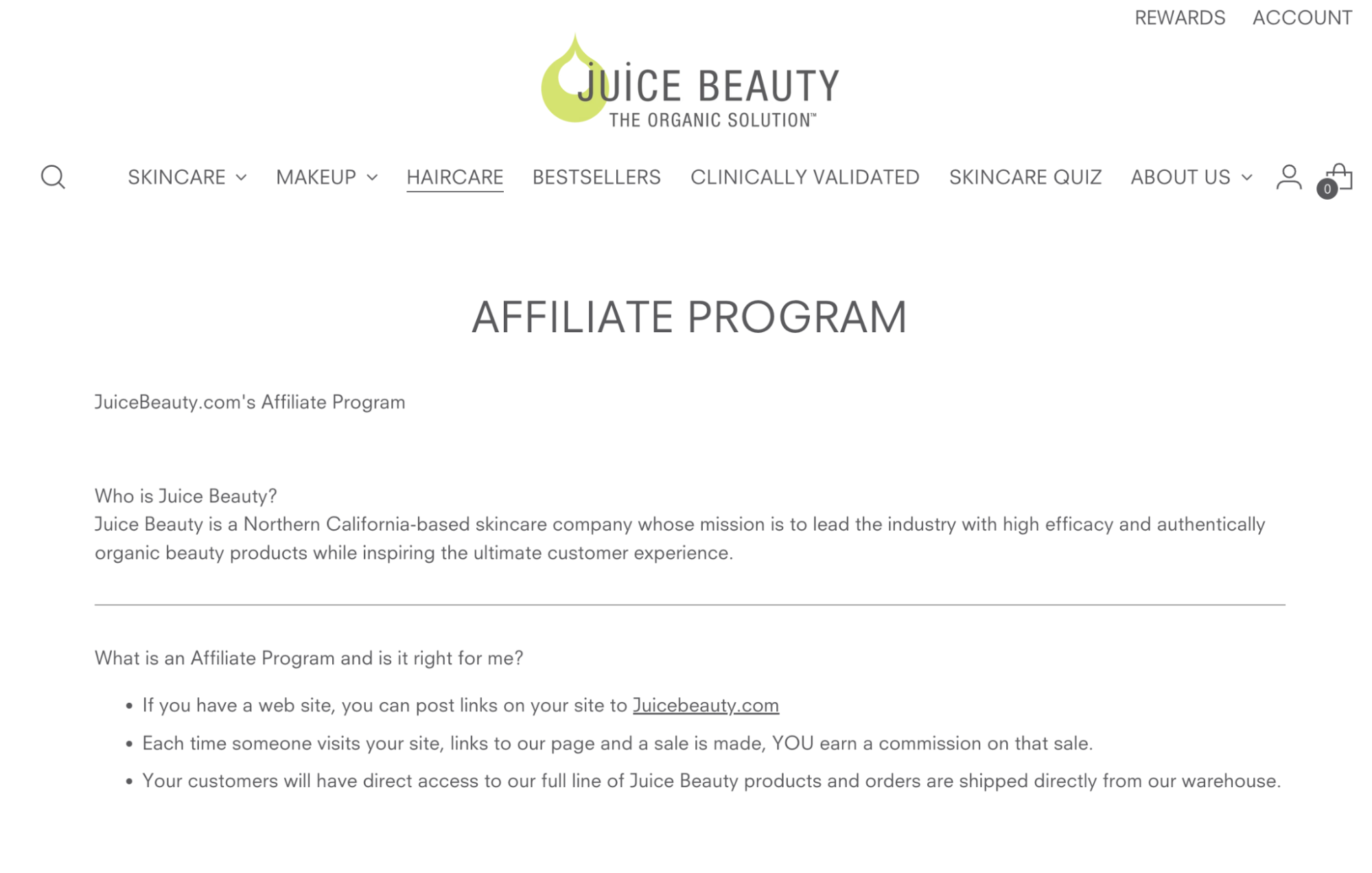
Juice Beauty
Juice Beauty is a skin care brand based in California that offers an affiliate program via Rakuten. Commission rates start at 6% on all sales and affiliates are provided with special deals and discounts. Juice Beauty doesn’t charge any application or membership fees to its affiliates.
EcoFlow
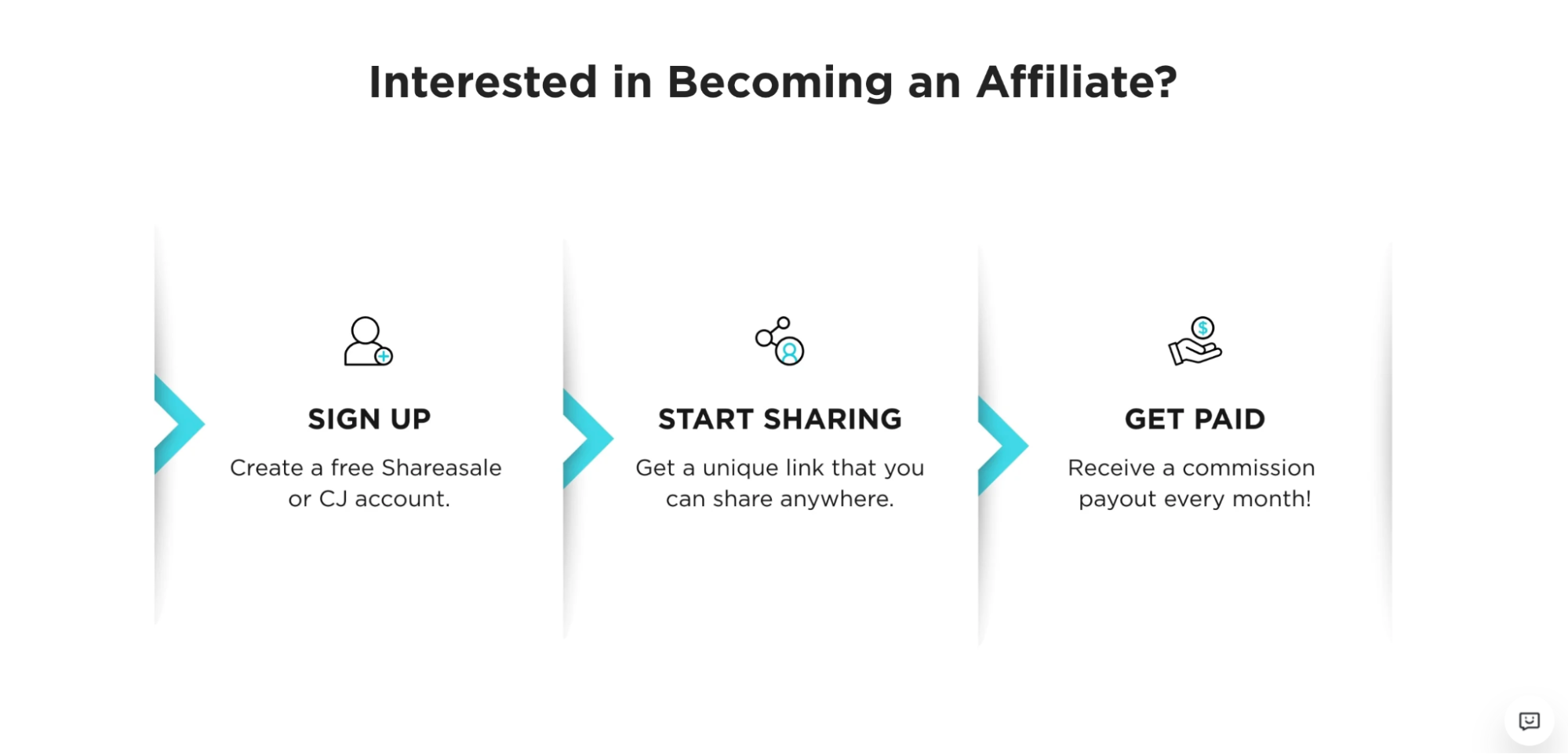
EcoFlow
EcoFlow is a brand of smart solar solutions. It makes products including portable air conditioners and generators. The company works with two different affiliate program partners and offers a 5% commission on each sale. Keep in mind, however, that the average order value is $1,000—meaning a $50 commission for your marketing efforts.
Manduka
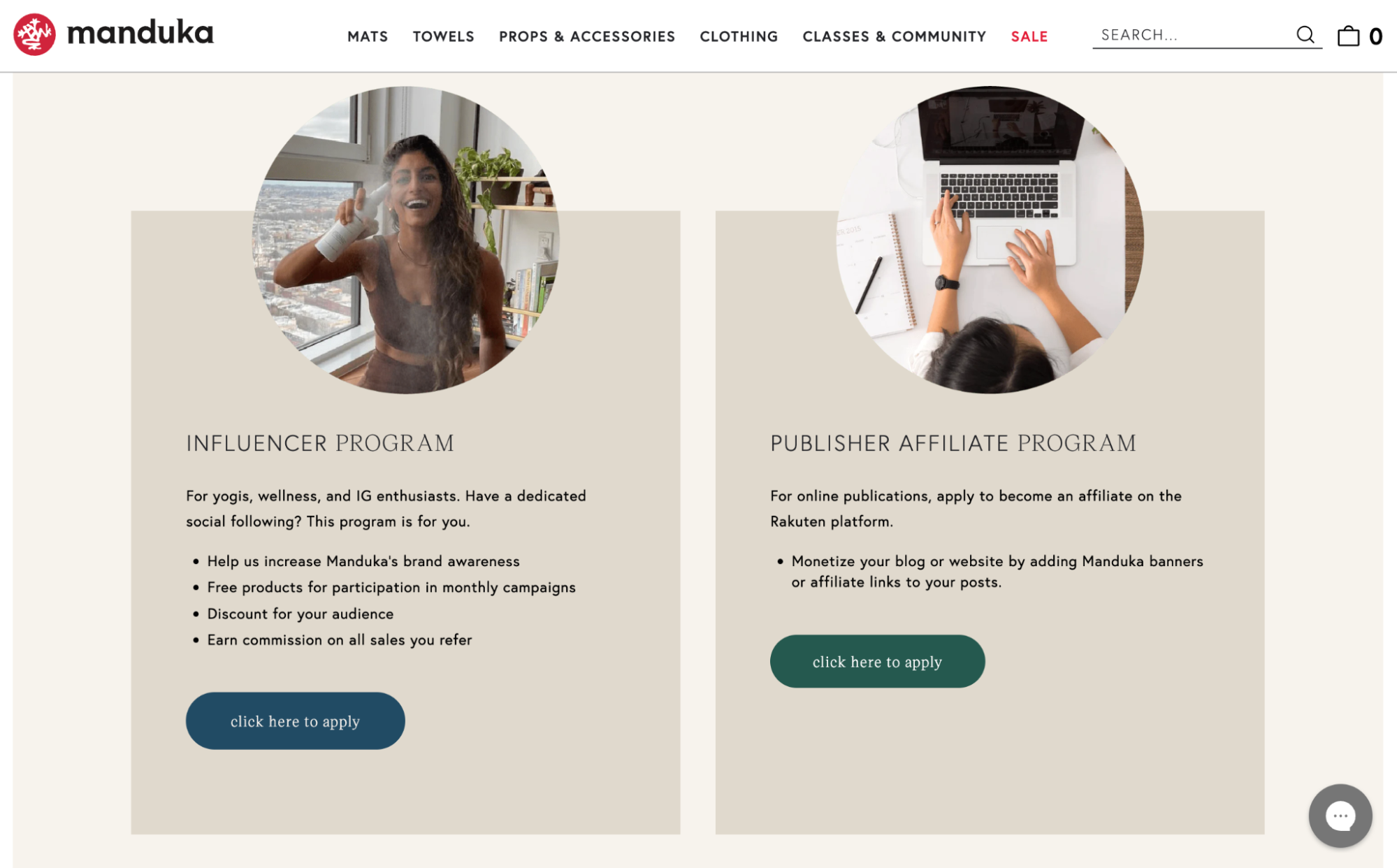
Manduka
Yoga brand Manduka offers a number of referral and affiliate programs for yoga teachers, influencers, and affiliate publishers. The diversity of this affiliate marketing strategy means that Manduka can connect the right partners with a program tailored to their channels or audiences.
Good To-Go
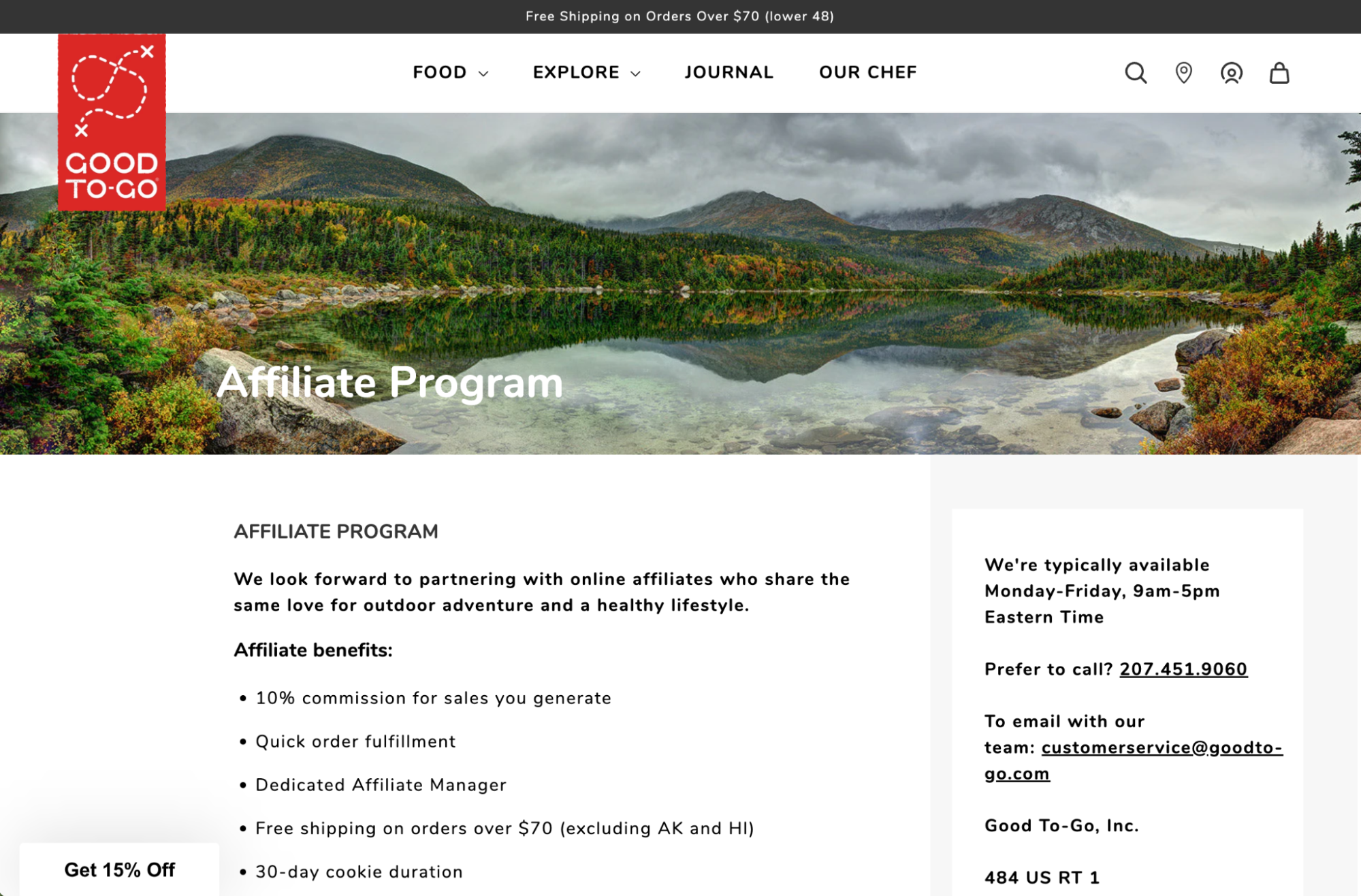
Good To-Go
Camping food brand Good To-Go offers an affiliate program with a 10% commission rate and other perks. Due to its niche market, Good To-Go can partner with social media influencers in the outdoor living space to run affiliate campaigns targeting its desired audience: campers and backpackers.
Start your affiliate marketing business today
Affiliate marketing can be a rewarding way to create a new revenue stream with minimal upfront investment. While it does require time and effort to find the right affiliate network and refine your strategy, the result can be a system that generates passive income for years into the future.
Affiliate marketing FAQ
What does affiliate marketing mean?
In affiliate marketing, affiliates earn a monetary commission by promoting a company’s product or service using an affiliate link. An affiliate partner is rewarded a commission for providing a specific result to a merchant or advertiser. The reward action can be a sale, lead, download, signup, or other valuable behavior. Affiliate income can be a percentage or dollar amount for each referral.
How do I start affiliate marketing?
You can start affiliate marketing by following these steps:
- Decide on a niche.
- Choose your platform.
- Find relevant affiliate marketing programs.
- Create valuable content.
- Build an audience.
- Follow FTC guidelines.
Is affiliate marketing worth it?
The affiliate marketing industry surpassed $8.2 billion in 2023, according to Statista. Affiliate marketing is inexpensive to start and carries low risk compared to other online business models.
What are the top affiliate networks?
Top affiliate networks include:
- Affiliate Future
- AvantLink
- CJ
- ClickBank
- FlexOffers
- LinkConnector
- ShareASale
What is an example of affiliate marketing?
Shopify offers an affiliate program where affiliates can refer merchants to the platform. It’s free to sign up. After a partner applies and gets approved for the affiliate marketing program, they receive a referral link. When a merchant signs up through the link for a paid Shopify plan, the affiliate partner earns a commission.
